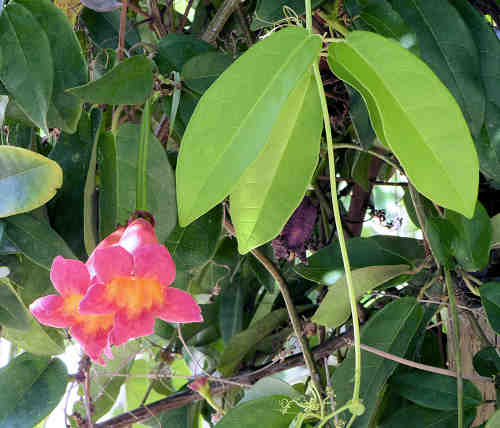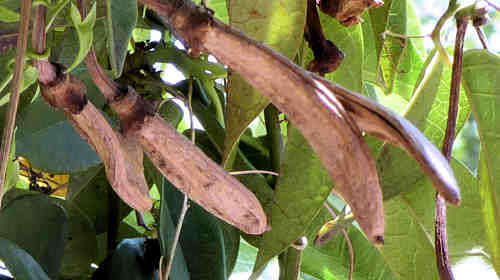Growing Bignonia capreolata:
Crossvine
Description
Form: A climbing vine.
Lifespan: Perennial.
Leaf retention: Evergreen in frost-free regions, deciduous in hard freezes.
Growth rate: Rapid.
Mature Size: 30-50' (9-15m) long.
Flowers: Large, bell-shaped, showy, clustered, fragrant. 'Tangerine Beauty' is orange outside, yellow inside. Other colors, including yellow and red, are available.
Bloom: Late winter to late spring. It may bloom sporadically summer to early fall, depending on the local climate.
Fruit: Dark brown, woody seedpods.
Leaves: Paired leaflets, lance-shaped, smooth edges, glossy green, turning to dark red in winter.
Stems: A square cross-section having a cross-shaped pith inside, resembling a Greek cross, which gives the vine its name. The stems are dark green, but turn reddish-purple in cold climates, and lack thorns. Slender tendrils, tipped with adhesive disks, assist climbing.
Roots: Crossvine forms underground tubers and spreads by stolons: above ground roots which form new plants where their nodes take root. In moist, fertile soils it becomes highly invasive.
Wildlife: The flowers attract hummingbirds, butterflies, and bees. The foliage is browsed by mammals.
Toxic / Danger: No.
Origin: Eastern United States, south of the Great Lakes to Texas.
Form: A climbing vine.
Lifespan: Perennial.
Leaf retention: Evergreen in frost-free regions, deciduous in hard freezes.
Growth rate: Rapid.
Mature Size: 30-50' (9-15m) long.
Flowers: Large, bell-shaped, showy, clustered, fragrant. 'Tangerine Beauty' is orange outside, yellow inside. Other colors, including yellow and red, are available.
Bloom: Late winter to late spring. It may bloom sporadically summer to early fall, depending on the local climate.
Fruit: Dark brown, woody seedpods.
Leaves: Paired leaflets, lance-shaped, smooth edges, glossy green, turning to dark red in winter.
Stems: A square cross-section having a cross-shaped pith inside, resembling a Greek cross, which gives the vine its name. The stems are dark green, but turn reddish-purple in cold climates, and lack thorns. Slender tendrils, tipped with adhesive disks, assist climbing.
Roots: Crossvine forms underground tubers and spreads by stolons: above ground roots which form new plants where their nodes take root. In moist, fertile soils it becomes highly invasive.
Wildlife: The flowers attract hummingbirds, butterflies, and bees. The foliage is browsed by mammals.
Toxic / Danger: No.
Origin: Eastern United States, south of the Great Lakes to Texas.
Cultivation and Uses
USDA hardiness zones: 5-9. This plant will die to the ground in very cold regions and come back from its roots in the spring.
Heat tolerant: Yes.
Drought tolerant: Yes, once established.
Sun: Full sun to open shade. Full sun produces the most flowers.
Soil: Well draining, dry, pH 6.1-7.8 (slightly acidic to slightly alkaline). This plant is tolerant of many soil types, but thrives in soil with high organic content. It tolerates continually moist soils once fully established.
Water after becoming established: Once a month or more often depending on appearance.
Mulch: No.
First Year Care: Water frequently until summer rains begin so it can establish a strong root system.
Planting: Crossvine can be grown in containers but will need more frequent watering.
Prune: After flowering, cut back to keep it in bounds. It flowers on old growth, so do not prune in winter.
Litter: Low.
Propagation: Seed and cuttings. The seeds have long germination time.
Uses: Crossvine is often grown on fences and trellises as an ornamental, but can be grown along the ground. It can be used as a privacy screen.
USDA hardiness zones: 5-9. This plant will die to the ground in very cold regions and come back from its roots in the spring.
Heat tolerant: Yes.
Drought tolerant: Yes, once established.
Sun: Full sun to open shade. Full sun produces the most flowers.
Soil: Well draining, dry, pH 6.1-7.8 (slightly acidic to slightly alkaline). This plant is tolerant of many soil types, but thrives in soil with high organic content. It tolerates continually moist soils once fully established.
Water after becoming established: Once a month or more often depending on appearance.
Mulch: No.
First Year Care: Water frequently until summer rains begin so it can establish a strong root system.
Planting: Crossvine can be grown in containers but will need more frequent watering.
Prune: After flowering, cut back to keep it in bounds. It flowers on old growth, so do not prune in winter.
Litter: Low.
Propagation: Seed and cuttings. The seeds have long germination time.
Uses: Crossvine is often grown on fences and trellises as an ornamental, but can be grown along the ground. It can be used as a privacy screen.
Comments
This plant is a member of the Trumpet Creeper family (Bignoniaceae). Crossvine is related to Campsis Radicans: Trumpet Vine, and is sometimes mistaken for it. While this plant is usually described as having medium water needs, it will tolerate much less water once established.
Do you have additional information or a different experience for these plants that you would like to share? Email info@GardenOracle.com. All contributions are welcome and appreciated.
This plant is a member of the Trumpet Creeper family (Bignoniaceae). Crossvine is related to Campsis Radicans: Trumpet Vine, and is sometimes mistaken for it. While this plant is usually described as having medium water needs, it will tolerate much less water once established.
Do you have additional information or a different experience for these plants that you would like to share? Email info@GardenOracle.com. All contributions are welcome and appreciated.



Latest update: September, 2024
© 2008-2025 by GardenOracle.com

